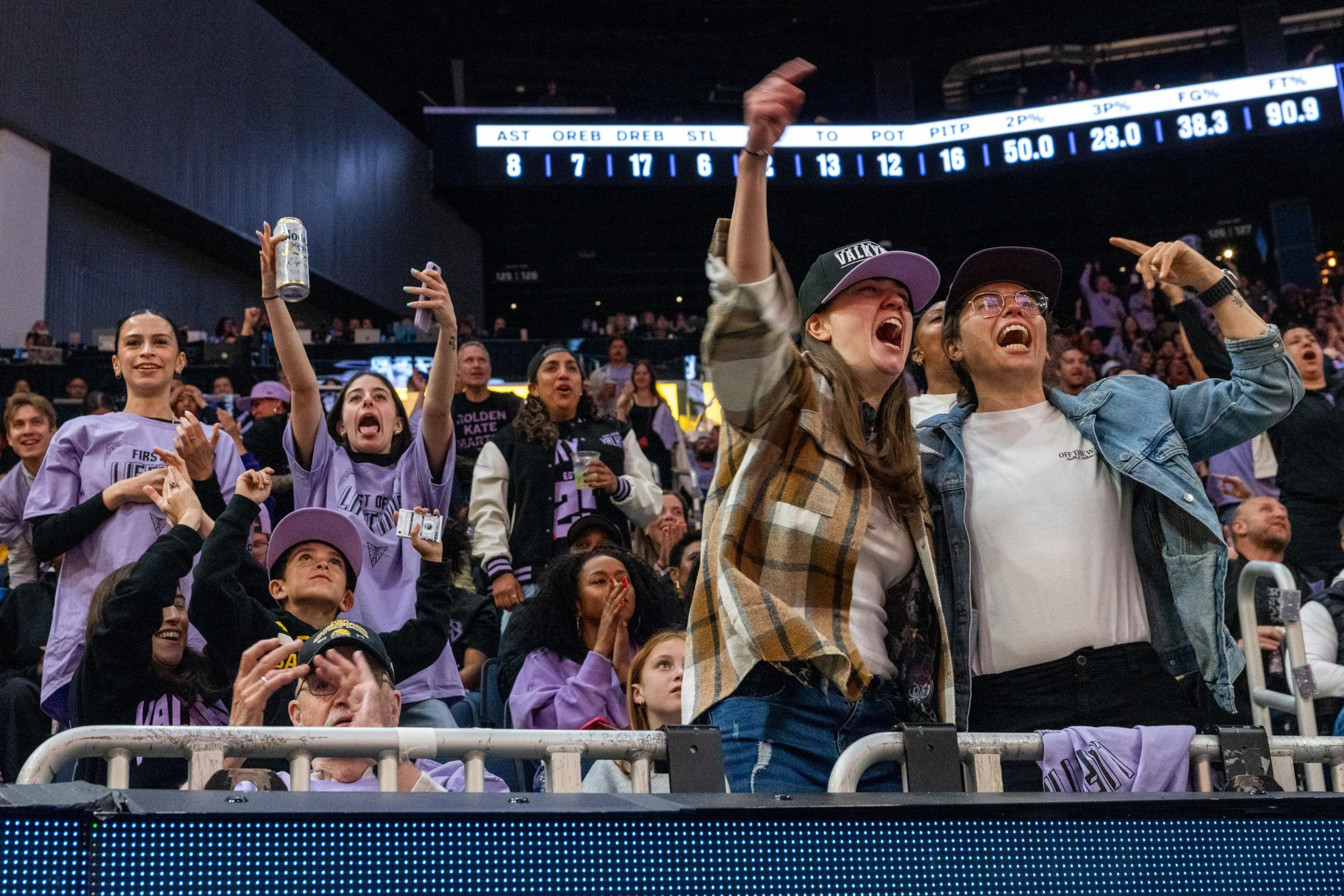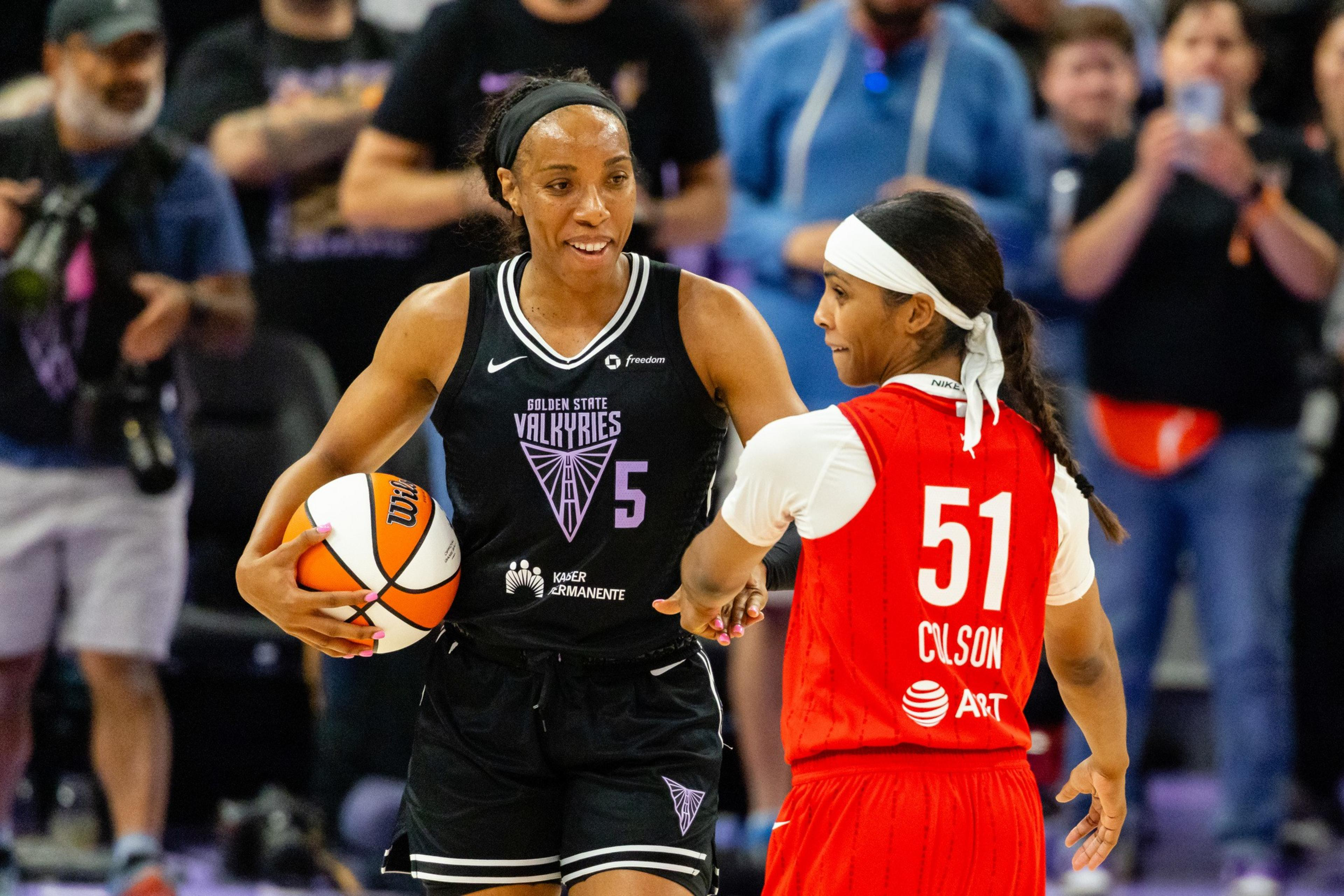Want the latest Bay Area sports news delivered to your inbox? Sign up here to receive regular email newsletters, including “The Dime.”
Amid one of the most grueling stretches of their season, the Golden State Valkyries won three consecutive road games for the first time this year, found new offensive X factors, and continued to make a push for a coveted playoff berth.
The expansion franchise is on the fast track to WNBA success, and with the right roster maneuvers in upcoming offseasons, Golden State could have a chance to meet owner Joe Lacob’s goal of winning a title in the team’s first five years.
Looming over the franchise’s sudden rise, however, is a potential threat to the momentum the Valkyries, and the WNBA as a whole, have generated.
In October, WNBA players opted out of their collective bargaining agreement, which is now set to expire Oct. 31. Women’s National Basketball Players Association members announced that they were seeking “a business model that reflects their true value.”
In March, WNBPA vice president Napheesa Collier made the stakes clear: “If a lockout is what it comes to, then I think we’re prepared for that.”
During the All-Star break last month, fellow WNBPA vice president Breanna Stewart called for “more of a sense of urgency” in collective bargaining agreement talks. With both sides eyeing the October deadline, the league is teetering on the edge of what could become its most consequential labor standoff yet.
What happens to everything the Valkyries have built if players and owners don’t reach an agreement on a CBA in time?

Ramifications of a lockout
Any delay in reaching a new CBA that results in an extended labor stoppage would push back offseason events — most notably the free agency period that begins in January. While this would affect all teams, with more than 100 players hitting the market — including 21 of this year’s 24 All-Stars becoming unrestricted free agents this offseason — the consequences could be even more significant for the Valkyries.
The opportunity to court and sign a marquee player in free agency is crucial. A disrupted or shortened free agency window could make it far more difficult to land the kind of superstar that could define the organization’s early years.
So if the negotiations linger, what could happen to free agency? The answer is layered — and potentially chaotic.
“If there is no CBA, but they are negotiating — we saw this with the NFL Draft in 2011 — they can choose to continue [operations],” Genevieve Birren, a sports management professor at SUNY Cortland, explained. “There is no rule that says when the CBA expires, you have to have a labor stoppage.”
In that case, the league and the union could agree to keep operating under the terms of the old CBA while negotiations continue — meaning free agency could proceed as scheduled.
That option would offer a level of stability, but it’s not without complications. For the players, agreeing to operate under the expiring deal means accepting the very cap restrictions and revenue sharing scheme they are fighting to change.
“The WNBA’s contracts and the CBA itself is very structured,” sports economist Craig Depken II explained. “Salaries are very regimented and specified, and that’s different from the MLB, NBA, or even NHL, where their CBAs have a very general contract, then individual players negotiate their own salaries.”

For the league and owners, however, the risk lies in another option: a landscape with no rules at all.
“If they haven’t agreed to operate under the terms, but they also haven’t had a labor stoppage, then in theory, it’s a free-for-all,” Birren said.
That scenario could lead to teams throwing money around without cap restrictions. Could it temporarily help Lacob, who has shown a propensity to invest in his team in ways other WNBA owners might not?
Not necessarily, as even the most aggressive owners would likely exercise extreme caution. Without a CBA in place, any attempt by the league to enforce salary cap or roster restrictions would likely violate antitrust laws.
“If the league operates as if the cap restrictions are in place, but there is no CBA, that’s an antitrust violation, because they would be putting an artificial restriction on trade,” Birren explained.
For the Valkyries, who are set to enter the offseason with six free agents, including Tiffany Hayes and Kayla Thornton (and four reserved free agents, including Janelle Salaün), this uncertainty could be particularly disruptive. Golden State has the most cap space in the league, with nearly $300,000 to work with, but navigating an undefined scene would complicate roster-building.
If free agency is paused altogether, that leaves the Valkyries and their pending free agents in limbo: no signings, no negotiations, no progress.
The organization would have to wait indefinitely to make roster decisions and set their payroll — and for a franchise looking to continue building an upward trajectory, that kind of uncertainty could cost them leverage and momentum. At best, the Valkyries may be forced into a holding pattern. At worst, they may miss their window to reshape the roster, depending on how long the negotiations drag out.
After all the sellouts, all the wins, and all the reasons Golden State has given the league’s highest-profile players to sign with the Valkyries, a shorter window to negotiate free-agent contracts could create a setback for a team that seems poised to cash in on an influx of attention and goodwill.

Lessons from other leagues
Previous conflicts in the NFL, NBA, MLB, and NHL have provided the WNBA with an important lesson: If a deal for a new CBA isn’t reached and a labor stoppage occurs, it’s critical that any strike or lockout doesn’t extend past the offseason and affect future games.
Perhaps no team would feel the loss of games more acutely than the Valkyries, who have sold out every home game this year and have built one of the league’s most rabid fan bases seemingly overnight.
With the WNBA experiencing record viewership, corporate sponsorship investment, and fan engagement, the stakes are higher than ever — not only in shaping player compensation but in maintaining the skyrocketing trajectory of the league itself.
Depken pointed to one key parallel between the NHL in the early 2000s and the WNBA today that he called “ominous” — like the WNBA, the NHL was enjoying peak popularity and a historic media rights deal before a labor dispute resulted in a season-long stoppage.
“What came out of the NHL lockout was a complete repricing of hockey talent — it was the exact opposite of what the players wanted. The players wanted more money, and they actually got less,” he said.
The consequences for the NHL work stoppage extended far beyond lost wages. The drawn-out labor battle didn’t just stall the sport’s momentum; it permanently damaged its market value.
“The NHL lost all of its television deals after ’04 for a bit, and it took them quite a while to recover — and they aren’t worth squat compared to some of the other leagues today,” Birren said. “It’s an example of how a league can kill its own momentum and really hurt itself with a protracted labor dispute.”
Hockey isn’t the only sport that has navigated public and extensive CBA negotiations.
In MLB, players have fought the narrative that they’re overpaid men playing a “boys game,” casting legitimate labor negotiations as ridiculous rather than a fight for fairness. A similar cultural undercurrent shapes public attitude toward the WNBA — but with a gendered twist. In this case, it’s not that players are seen as entertainers asking for more; it’s that they are women, and the underlying message is that they should be grateful for the opportunity at all.
This narrative undermines the legitimacy of their demands and shifts attention away from the revenue-structure issues. In the NBA, players receive roughly half of all basketball-related income, which is used to set the salary cap. In the WNBA, players reportedly receive about 9% of all basketball-related income, and the CBA sets the salary cap.
“They are individuals with a really unique skill set, and they deserve a chance,” Krister Swanson, author of “Baseball’s Power Shift,” explained. “In the United States, in theory, we believe in freedom of contract — that you should be able to take your goods or services to the marketplace and earn the maximum available compensation based on what the marketplace will pay. And right now, you could make a good case that the way that ownership is treating them is basically collusive behavior designed to suppress their value.”
Unlike MLB, which has sometimes dealt with fractures in the Players Union, the WNBPA enters negotiations with a deep sense of player solidarity and an increasingly vocal fanbase.
After the Valkyries’ blowout win June 22 over the Sun, star forward Kayla Thornton sat down for a postgame press conference. Instead of immediately answering questions, she read a statement: “This is a defining moment for the WNBA as the league grows.”
She added: “It’s business. We’re not fighting for anything unreasonable.”
That same day, high-profile players from around the league echoed the prepared statement.

The league’s players have consistently presented a united front — not just on revenue-sharing but on broader issues of gender, race, and justice — and that collective stance has helped the WNBPA build a unified voice that can strengthen its bargaining position and reshape the stakes in the eyes of the public.
That unity, combined with growing recognition of the structural inequities WNBA players face within their current CBA, sets the stage for a different kind of labor standoff — one in which public sentiment might finally lean toward the athletes.
“In the NBA, NFL, and MLB, the public has little patience for strikes and lockouts, because they see multimillionaires fighting with billionaires,” Richard Karcher, a sport law professor at Eastern Michigan University, explained. “But the public support would definitely be on the side of the players in a WNBA work stoppage.”
Unlike other professional sports leagues, where CBA battles are optics wars between the wealthy and wealthier, the WNBPA’s fight is seen more clearly for what it is: workers demanding a fair share of the value they helped create.
Sportico this summer crowned the Valkyries as the most valuable team in the WNBA, with a $500 million franchise valuation. Holding that title as the league’s youngest organization is not just a marker of the exponential growth of women’s basketball; it’s a statement about where the league is headed: to the forefront of profitability. And it’s the players who are leading the charge.




